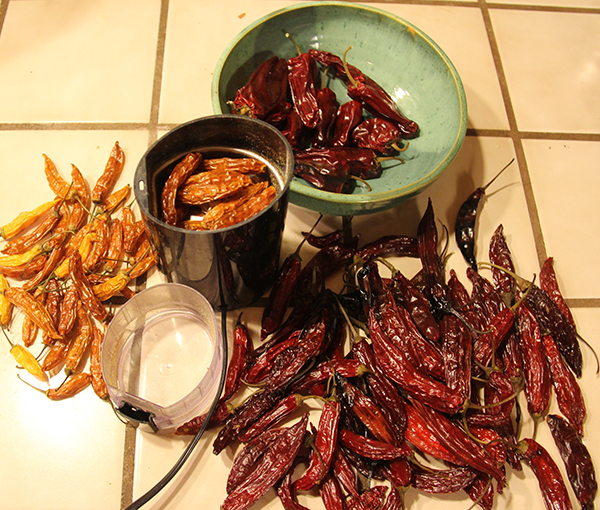by Birgitt Evans, Master Gardener
It’s dry out there in the garden now. And hot. The heat lovers like tomatoes, peppers, eggplants, basil, corn and melons are loving it. As long as they get enough water, they will shine, producing generous crops.
This time of bounty is an opportunity to do some great cooking for your family, to experiment with new recipes and see if you can use up (or trade) all the produce from the garden. It is also time to look to putting up a good deal of that produce so you can have a taste of summer in the winter. I will refer you here to Margie Siegal’s great book review in this issue on her favorite canning resource to use up tomatoes, tomatillos, peaches and other acidic fruits. You can also dry peppers or roast them and store them in oil in the fridge. Corn, blueberries, strawberries and tomatoes can be frozen and used in meals in January. Don’t forget herbs! While most herbs grow well through the winter, this is the time to dry them and jar them up so that you aren’t traipsing through the mud with a flashlight as you prepare December dinners. Be sure to preserve basil and sage as they won’t be harvestable in the winter.
But at some point, they will come to an end, leaving a hole in the garden ready to be filled. Physician and counselor Rachel Reman referred to this as “endbeginning”, because every ending creates possibilities. Early September can be tricky in our area though. We can have cooling fog, but also Indian Summer heat. The powdery mildew is waiting to bring down the squash and cucumbers and the white cabbage looper caterpillars can devour young brassica plants. Realistically, it is too late to plant the fruiting plants plus corn and beans – you won’t get a crop before the cool dark nights of October. So what to plant now?
Provided you commit to keeping the seeds watered, this is a great time to plant some of the rooting crops, like carrots, turnips and beets. They will overwinter well in our climate and you can eat (some of) the greens of the turnips and beets before harvesting late fall or early spring crops of roots. Brassicas like broccoli and cauliflower can be started in containers in a protected spot, preferably with some kind of mesh covering to keep the cabbage butterflies from laying eggs on the seedlings, and transplanted in late September. Peas are wonderful and can be planted directly in mid to late September when the worst of the heat is over. Remember to ask your favorite nursery if the plants they grow and sell are grown or sprayed with insecticides. Your questions and concerns can lead to positive changes!
When I am preparing to plant anything, I look first to the compost pile for botanical inspiration in the form of organic matter and microbes to help my plants grow strong. And in our intensively planted gardens or containers, fertilizer with every crop is a necessity.
Alternatively, you might decide to plant some or all of the open spaces in your garden in cover crop to build the soil for future years. Be sure to select a mix that contains both legumes that fix nitrogen and grains to provide the carbon necessary for decomposition.
I will add a word about worms in here as well. Worms are living creatures and they are affected by summer heat. Worm bins should be in total shade in the summer. When you get too hot, so do they. First they go down and then they will try to escape through the spigot. Once they have gone down, they may not be able to get back up to the food again and if the lowest level gets too acidic, they will die en masse. So you can’t just set up a worm bin and forget it. You need to monitor it and work your worms.
Finally, be sure to water everything well in September and mulch your crops, new and old until the October rains arrive. Here in Alameda, August is not the end of the gardening year, but rather the beginning of the next season.

